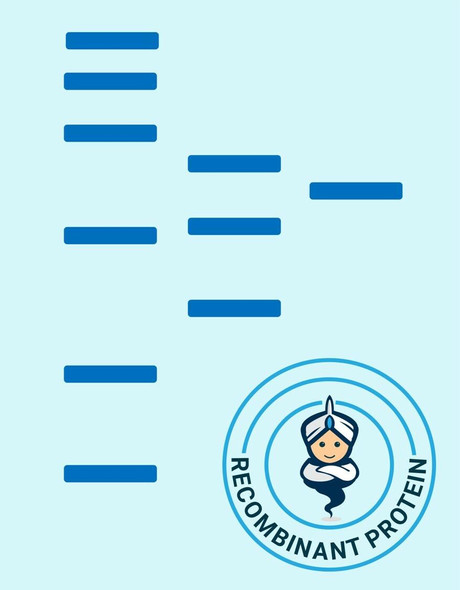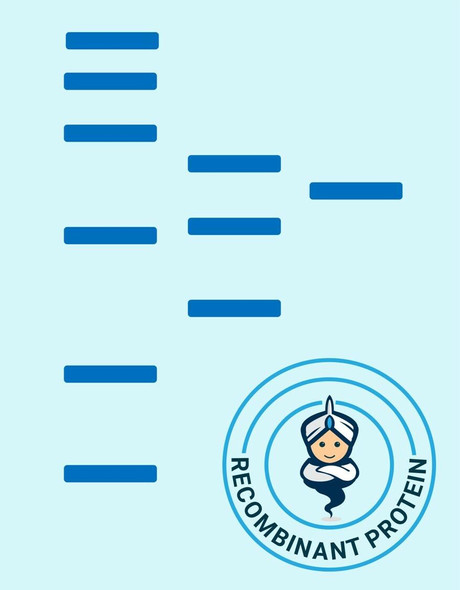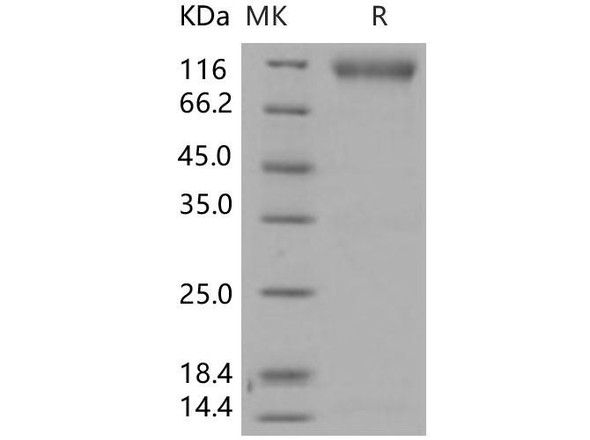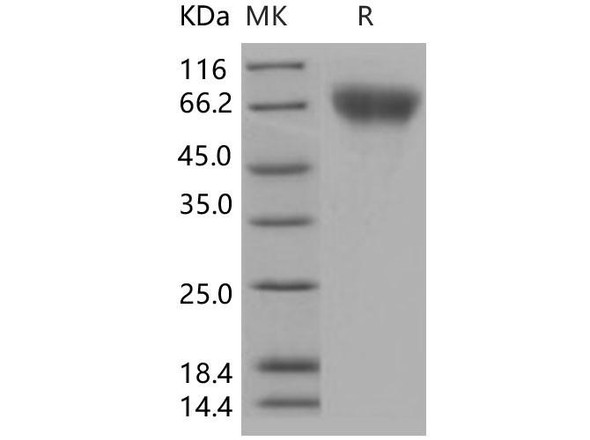Enzymes Recombinant Proteins
Human FGFR2 Recombinant Protein (RPPB2519)
- SKU:
- RPPB2519
- Product Type:
- Recombinant Protein
- Species:
- Human
- Uniprot:
- P21802
- Research Area:
- Enzymes
Description
| Product Name: | Human FGFR2 Recombinant Protein |
| Product Code: | RPPB2519 |
| Size: | 10µg |
| Species: | Human |
| Target: | FGFR2 |
| Synonyms: | EC 2.7.10, FGFR-2, BFR-1, CD332, BBDS, CEK3, ECT1, TK14, TK25, CFD1, KSAM, JWS, Fibroblast Growth Factor Receptor 2, Keratinocyte Growth Factor Receptor, Bacteria-Expressed Kinase, EC 2.7.10.1, K-SAM, KGFR, BEK, Protein Tyrosine Kinase, Receptor Like 14, BEK Fibroblast Growth Factor Receptor, Craniofacial Dysostosis 1, Jackson-Weiss Syndrome, Pfeiffer Syndrome, Crouzon Syndrome, CD332 Antigen. |
| Source: | Sf9 Insect cells |
| Physical Appearance: | Sterile Filtered colorless solution. |
| Formulation: | FGFR2 protein solution (0.5mg/ml) contains Phosphate Buffered Saline (pH 7.4) and 10% glycerol. |
| Stability: | Store at 4°C if entire vial will be used within 2-4 weeks. Store, frozen at -20°C for longer periods of time.�For long term storage it is recommended to add a carrier protein (0.1% HSA or BSA).�Avoid multiple freeze-thaw cycles. |
| Purity: | Greater than 95.0% as determined by SDS-PAGE. |
| Amino Acid Sequence: | RPSFSLVEDT TLEPEDAISS GDDEDDTDGA EDFVSENSNN KRAPYWTNTE KMEKRLHAVPAANTVKFRCP AGGNPMPTMR WLKNGKEFKQ EHRIGGYKVR NQHWSLIMES VVPSDKGNYTCVVENEYGSI NHTYHLDVVE RSPHRPILQA GLPANASTVV GGDVEFVCKV YSDAQPHIQWIKHVEKNGSK YGPDGLPYLK VLKHSGINSS NAEVLALFNV TEADAGEYIC KVSNYIGQANQSAWLTVLPK QQAPGREKEI TASPDYLELE PKSCDKTHTC PPCPAPELLG GPSVFLFPPKPKDTLMISRT PEVTCVVVDV SHEDPEVKFN WYVDGVEVHN AKTKPREEQY NSTYRVVSVLTVLHQDWLNG KEYKCKVSNK ALPAPIEKTI SKAKGQPREP QVYTLPPSRD ELTKNQVSLTCLVKGFYPSD IAVEWESNGQ PENNYKTTPP VLDSDGSFFL YSKLTVDKSR WQQGNVFSCSVMHEALHNHY TQKSLSLSPG KHHHHHH |
Fibroblast Growth Factors (FGFs) comprise a family of at least 18 structurally related proteins that take part in a multitude of physiological and pathological cellular processes, includingdifferentiation, cell growth, angiogenesis, wound healing and tumorgenesis. The biological activities of the FGFs are mediated by a family if type I transmembrane tyrosine kinases which undergo dimerization and autophosphorylation after ligand binding. 4 different genes encoding related FGF receptors. Multiple forms of FGFR-1 to -3 are generated by alternative splicing of the mRNAs. A frequent splicing event involving FGFR-1 and -2 results in receptors containing all three Ig domains, referred to as the alpha isoform, or only IgII and IgIII. Only the alpha isoform has been identified for FGFR-3 and FGFR-4. Additional splicing events for FGFR-1 to -3, involving the C-terminal half of the IgIII domain encoded by 2 mutually exclusive alternative exons, generate FGF receptors with alternative IgIII domains (IIIb and IIIc). A IIIa isoform which is a secreted FGF binding protein containing only the N-terminal half of the IgIII domain plus some intron sequences has also been reported for FGFR-1.
FGFR2 produced in Sf9 Baculovirus cells is a single, glycosylated polypeptide chain containing 507 amino acids (22-289a.a.) and having a molecular mass of 56.8kDa. FGFR2 is expressed with a 239 amino acid hIgG-His-Tag at C-Terminus and purified by proprietary chromatographic techniques.
| UniProt Protein Function: | FGFR2: a receptor tyrosine kinase of the highly-conserved FGFR family that binds fibroblast growth factor (FGF). Mutations are associated with many craniosynostotic syndromes and bone malformations. Mutations cause syndromes with defects in facial and limb development, including Crouzon syndrome, Beare-Stevenson cutis gyrata syndrome, Pfeiffer syndrome, Apert syndrome, and Jackson-Weiss syndrome. Somatic mutations seen in gastric cancer. Amplified in gastric, breast and some B cell cancers, but deleted in glioblastoma Twenty splice-variant isoforms have been described. |
| UniProt Protein Details: | Protein type:EC 2.7.10.1; FGFR family; Kinase, protein; Membrane protein, integral; Oncoprotein; Protein kinase, TK; Protein kinase, tyrosine (receptor); TK group Chromosomal Location of Human Ortholog: 10q26.13 Cellular Component: cell cortex; cell surface; cytoplasm; excitatory synapse; extracellular matrix; integral to plasma membrane; intracellular membrane-bound organelle; nucleoplasm; nucleus; plasma membrane Molecular Function:1-phosphatidylinositol-3-kinase activity; fibroblast growth factor binding; fibroblast growth factor receptor activity; phosphatidylinositol-4,5-bisphosphate 3-kinase activity; protein binding; protein homodimerization activity; protein-tyrosine kinase activity; Ras guanyl-nucleotide exchange factor activity Biological Process: alveolus development; angiogenesis; axonogenesis; bone mineralization; branching morphogenesis of a nerve; cell fate commitment; cell-cell signaling; embryonic cranial skeleton morphogenesis; embryonic digestive tract morphogenesis; embryonic organ development; embryonic organ morphogenesis; embryonic pattern specification; epidermis morphogenesis; epithelial cell differentiation; fibroblast growth factor receptor signaling pathway; gland morphogenesis; gut development; hair follicle morphogenesis; in utero embryonic development; inner ear morphogenesis; lacrimal gland development; limb bud formation; lung development; MAPKKK cascade; mesenchymal cell differentiation; midbrain development; morphogenesis of embryonic epithelium; multicellular organism growth; negative regulation of transcription from RNA polymerase II promoter; neuroblast division in the ventricular zone; odontogenesis; orbitofrontal cortex development; organ growth; organ morphogenesis; otic vesicle formation; peptidyl-tyrosine phosphorylation; phosphoinositide-mediated signaling; positive regulation of cardiac muscle cell proliferation; positive regulation of cell cycle; positive regulation of cell division; positive regulation of cell proliferation; positive regulation of epithelial cell proliferation; positive regulation of MAPKKK cascade; positive regulation of mesenchymal cell proliferation; positive regulation of transcription from RNA polymerase II promoter; positive regulation of Wnt receptor signaling pathway; post-embryonic development; protein amino acid autophosphorylation; pyramidal neuron development; regulation of cell fate commitment; regulation of fibroblast growth factor receptor signaling pathway; regulation of multicellular organism growth; regulation of osteoblast differentiation; regulation of osteoblast proliferation; regulation of phosphoinositide 3-kinase cascade; regulation of smooth muscle cell differentiation; regulation of smoothened signaling pathway; reproductive structure development; skeletal morphogenesis; ureteric bud development; ventricular cardiac muscle morphogenesis Disease: Antley-bixler Syndrome Without Genital Anomalies Or Disordered Steroidogenesis; Apert Syndrome; Beare-stevenson Cutis Gyrata Syndrome; Bent Bone Dysplasia Syndrome; Crouzon Syndrome; Gastric Cancer; Jackson-weiss Syndrome; Lacrimoauriculodentodigital Syndrome; Pfeiffer Syndrome; Saethre-chotzen Syndrome; Scaphocephaly, Maxillary Retrusion, And Mental Retardation |
| NCBI Summary: | The protein encoded by this gene is a member of the fibroblast growth factor receptor family, where amino acid sequence is highly conserved between members and throughout evolution. FGFR family members differ from one another in their ligand affinities and tissue distribution. A full-length representative protein consists of an extracellular region, composed of three immunoglobulin-like domains, a single hydrophobic membrane-spanning segment and a cytoplasmic tyrosine kinase domain. The extracellular portion of the protein interacts with fibroblast growth factors, setting in motion a cascade of downstream signals, ultimately influencing mitogenesis and differentiation. This particular family member is a high-affinity receptor for acidic, basic and/or keratinocyte growth factor, depending on the isoform. Mutations in this gene are associated with Crouzon syndrome, Pfeiffer syndrome, Craniosynostosis, Apert syndrome, Jackson-Weiss syndrome, Beare-Stevenson cutis gyrata syndrome, Saethre-Chotzen syndrome, and syndromic craniosynostosis. Multiple alternatively spliced transcript variants encoding different isoforms have been noted for this gene. [provided by RefSeq, Jan 2009] |
| UniProt Code: | P21802 |
| NCBI GenInfo Identifier: | 120049 |
| NCBI Gene ID: | 2263 |
| NCBI Accession: | P21802.1 |
| UniProt Secondary Accession: | P21802,P18443, Q01742, Q12922, Q14300, Q14301, Q14302 Q14303, Q14304, B4DFC2, E7EVR6, E9PCR0, |
| UniProt Related Accession: | P21802 |
| Molecular Weight: | 79,833 Da |
| NCBI Full Name: | Fibroblast growth factor receptor 2 |
| NCBI Synonym Full Names: | fibroblast growth factor receptor 2 |
| NCBI Official Symbol: | FGFR2�� |
| NCBI Official Synonym Symbols: | BEK; JWS; BBDS; CEK3; CFD1; ECT1; KGFR; TK14; TK25; BFR-1; CD332; K-SAM�� |
| NCBI Protein Information: | fibroblast growth factor receptor 2 |
| UniProt Protein Name: | Fibroblast growth factor receptor 2 |
| UniProt Synonym Protein Names: | K-sam; KGFR; Keratinocyte growth factor receptor; CD_antigen: CD332 |
| Protein Family: | Tumor necrosis factor receptor superfamily |
| UniProt Gene Name: | FGFR2�� |






